Overview
The key differences between branding and logos are pivotal within a marketing strategy. Branding encompasses the overall identity and emotional connection of a business, while a logo serves as a visual symbol for quick recognition. A strong brand identity, supported by a well-designed logo, fosters customer loyalty and trust. Statistics reveal that companies with cohesive branding can significantly enhance their market presence and consumer engagement. This underscores the necessity for businesses to prioritize both branding and logo design in their marketing efforts.
Introduction
Understanding the distinction between branding and logos is crucial for businesses aiming to thrive in a competitive landscape. Branding encompasses the broader narrative and emotional connections that foster loyalty, while logos serve as the visual shorthand that captures attention and enhances recognition. This article delves into the intricate interplay between these two elements, exploring how effective strategies can elevate a company's market presence.
As organizations navigate the complexities of consumer behavior and brand perception, the challenge remains: how can they harmonize their branding and logo to create a cohesive identity that resonates deeply with their audience?
Define Branding and Logos: Core Concepts
The process of branding involves creating a unique brand and logo that establishes a distinctive identity for a business or product, encompassing its core values, mission, and overall market perception. This process involves strategic storytelling and fostering emotional connections with consumers, essential for building trust and loyalty. In contrast, a brand mark is a specific graphic element that visually encapsulates a brand's identity, serving as a recognizable symbol. While brand and logo are essential elements of brand identity, they signify only one aspect of a that also encompasses messaging, customer experience, and visual identity.
The importance of brand identity in achieving business success cannot be overstated. Research shows that companies with robust identities can command higher prices and enjoy greater customer loyalty. For instance, companies that successfully convey their distinct values and missions, such as Patagonia, not only boost their market visibility but also connect profoundly with customers, resulting in heightened engagement and loyalty. In fact, 71% of consumers are more likely to buy from companies they trust, highlighting the critical role of identity in fostering consumer relationships.
As we near 2025, the marketing environment continues to transform, with an increasing focus on authenticity and heritage. Successful companies are shifting their focus from mere aesthetics to their unique narratives and values, ensuring they remain relevant in a crowded marketplace. Case studies, like those of Mary Louise Cosmetics and Eyecart, illustrate how effective marketing strategies can result in substantial growth in customer loyalty and revenue. Mary Louise Cosmetics, for example, achieved a 126% increase in repurchase rates year-over-year by leveraging its heritage-inspired narrative.
In summary, while a brand and logo are crucial visual representations of an identity, it is the wider marketing strategy that ultimately propels business success. A well-designed identity not only distinguishes a business from its rivals but also establishes trust and nurtures enduring relationships with clients.
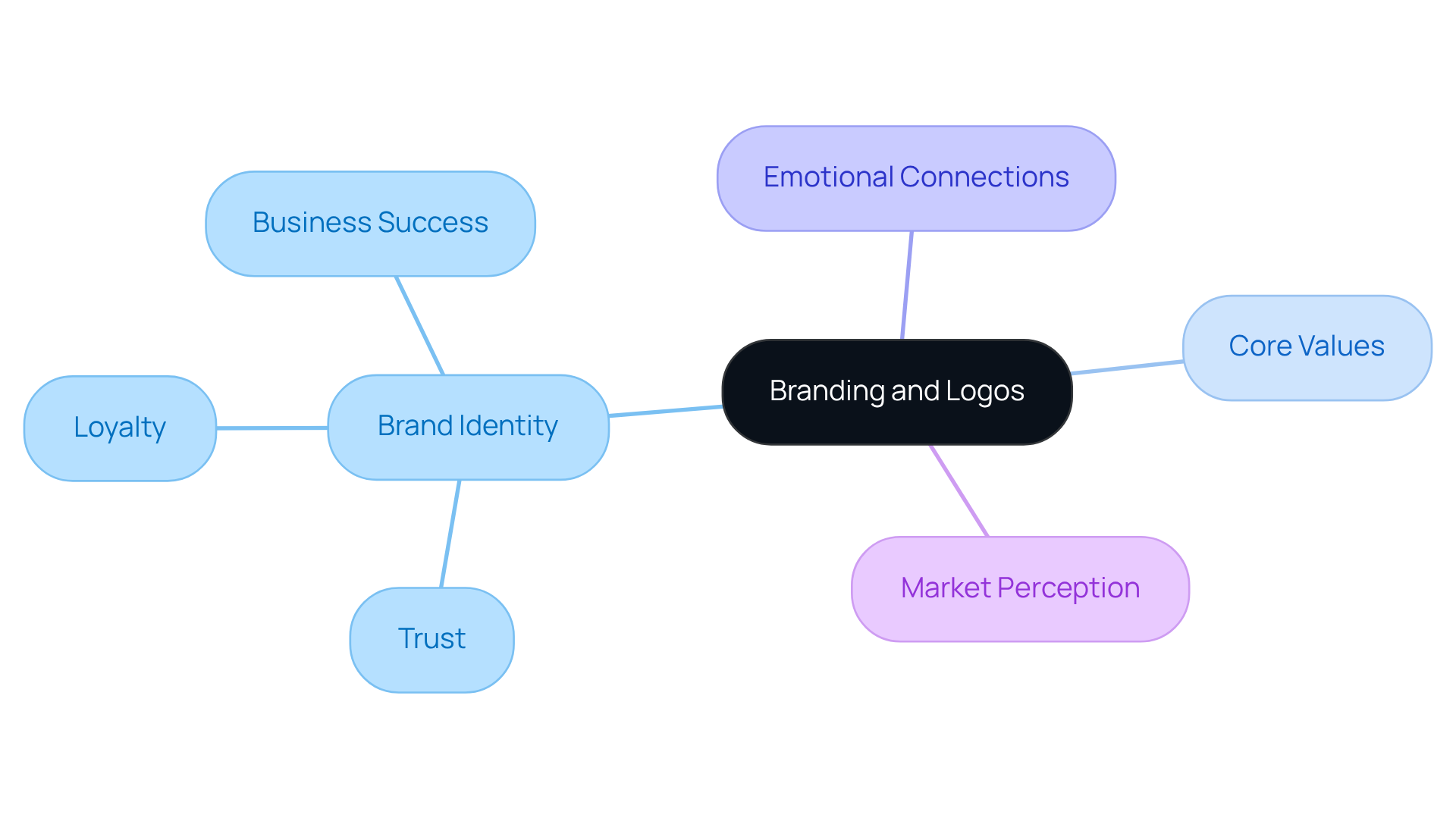
Contrast Functions: Branding vs. Logos in Marketing
Branding serves as a comprehensive strategy that shapes buyer perceptions and fosters loyalty over time. It encompasses every interaction a customer has with a company—from advertising to customer support—creating an experience that resonates deeply with audiences. In contrast, symbols act as visual shortcuts that enhance recognition, often representing the initial point of contact for consumers. A well-designed logo can evoke immediate emotional responses, making it essential for visibility in competitive markets.
At Overskies, we harness the power of AI to drive growth and enhance profitability through personalized storytelling. Our innovative approach allows us to produce scalable creative content that connects with audiences, ensuring that every interaction reflects the entity's unique identity. We utilize AI to monitor public sentiment and refine ad versions, enhancing our ability to develop targeted and effective advertising. Statistics reveal that a consistent identity across all platforms can increase revenue by as much as 23%, underscoring the importance of a unified image in cultivating consumer loyalty. This consistency fosters , which are crucial for establishing lasting relationships with customers.
Marketing experts emphasize that while logos attract interest, a successful brand identity forges stronger emotional connections. Companies like Nike and Patagonia exemplify this, having effectively employed their marketing strategies to build devoted customer bases. Nike's 'Just Do It' campaign not only inspires perseverance but also resonates emotionally with consumers, while Patagonia's commitment to environmental responsibility aligns seamlessly with the values of eco-conscious customers.
As we approach 2025, the role of symbols in company recognition remains pivotal. They facilitate quick recollection and form the foundation of a company's identity. A powerful symbol, when paired with a compelling narrative, enhances trust and nurtures long-term loyalty among consumers. At Overskies, we leverage AI to optimize campaigns and craft compelling visual narratives that elevate identities through strategic communication. As noted, 'A symbol may attract attention, but a trademark captures the heart,' highlighting the emotional aspect of identity. In a landscape where first impressions matter, it is imperative for businesses aiming to thrive to invest in both their brand and logo design.
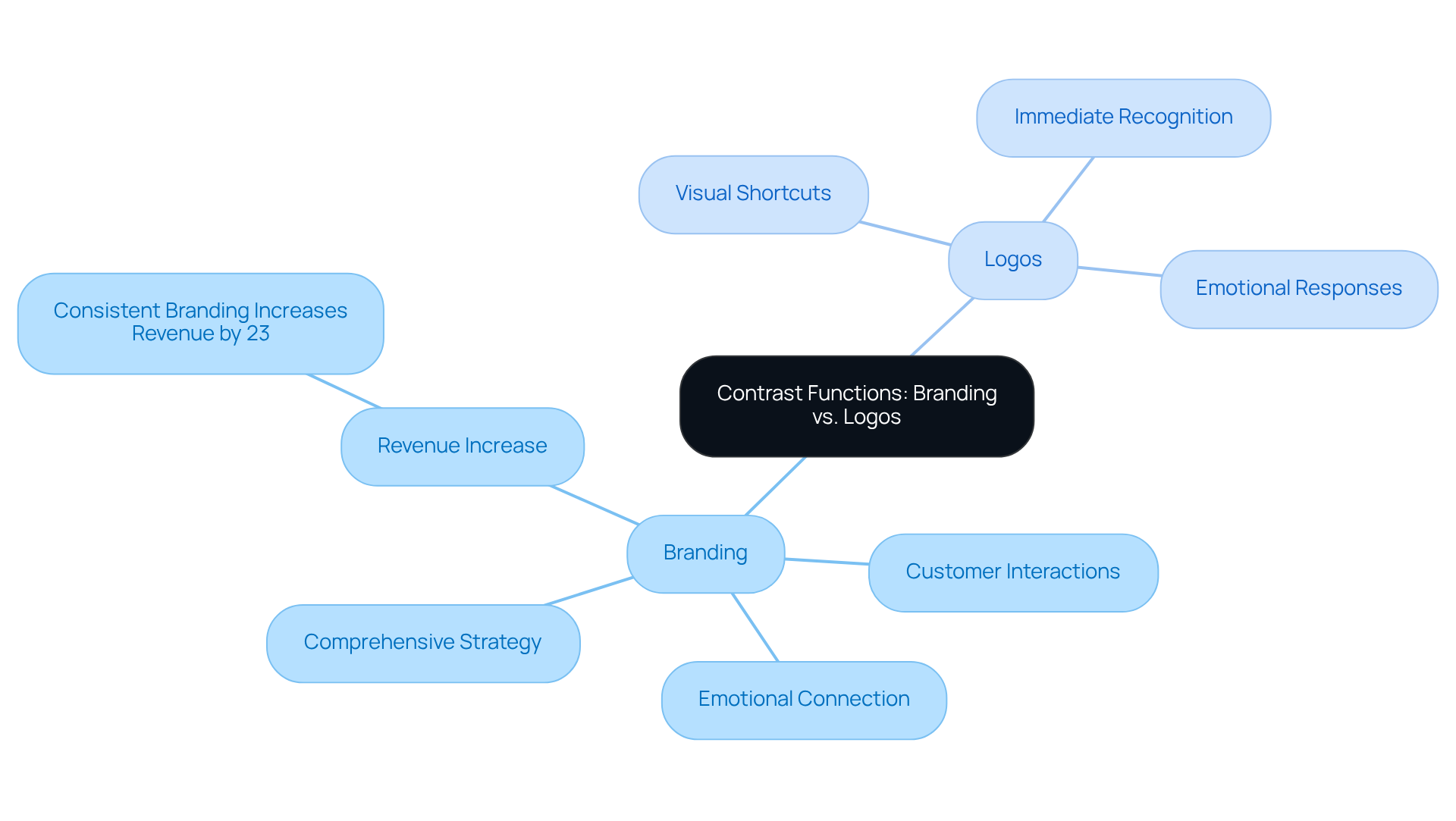
Leverage Strategies: Utilizing Branding and Logos Effectively
To maximize branding effectiveness, companies must prioritize the development of a unified narrative that resonates deeply with their target audience and aligns with their brand and logo. This necessitates consistent communication across all platforms and touchpoints, ensuring that every interaction strengthens the core values of the organization. A well-designed brand and logo play a pivotal role in this process; they should be simple, memorable, and versatile enough to adapt across various media.
Utilizing and careful typography can greatly improve the visual identity's capacity to convey the company's essence. Furthermore, incorporating the brand and logo into all marketing materials not only enhances recognition but also creates a strong visual identity. Frequent evaluations and revisions to branding strategies, guided by customer feedback, are crucial for sustaining relevance and encouraging engagement.
Additionally, brick-and-mortar establishments can significantly contribute to narratives by providing tangible experiences that complement online interactions. Statistics indicate that 71% of consumers are more likely to buy from companies they trust, underscoring the importance of a cohesive narrative in establishing that trust and loyalty.
As B2C organizations navigate the evolving retail landscape, they encounter challenges such as adapting to e-commerce trends and maintaining customer engagement. Consequently, it is essential to recognize and execute marketing initiatives that have been top priorities for B2C companies this year, ensuring alignment with customer values and preferences. A clear purpose for the company is also essential, guiding decisions and ensuring alignment with customer values.
As emphasized by Overskies, leveraging narrative marketing and connection-focused strategies can further enhance audience engagement, thereby boosting demand in an increasingly digital environment.
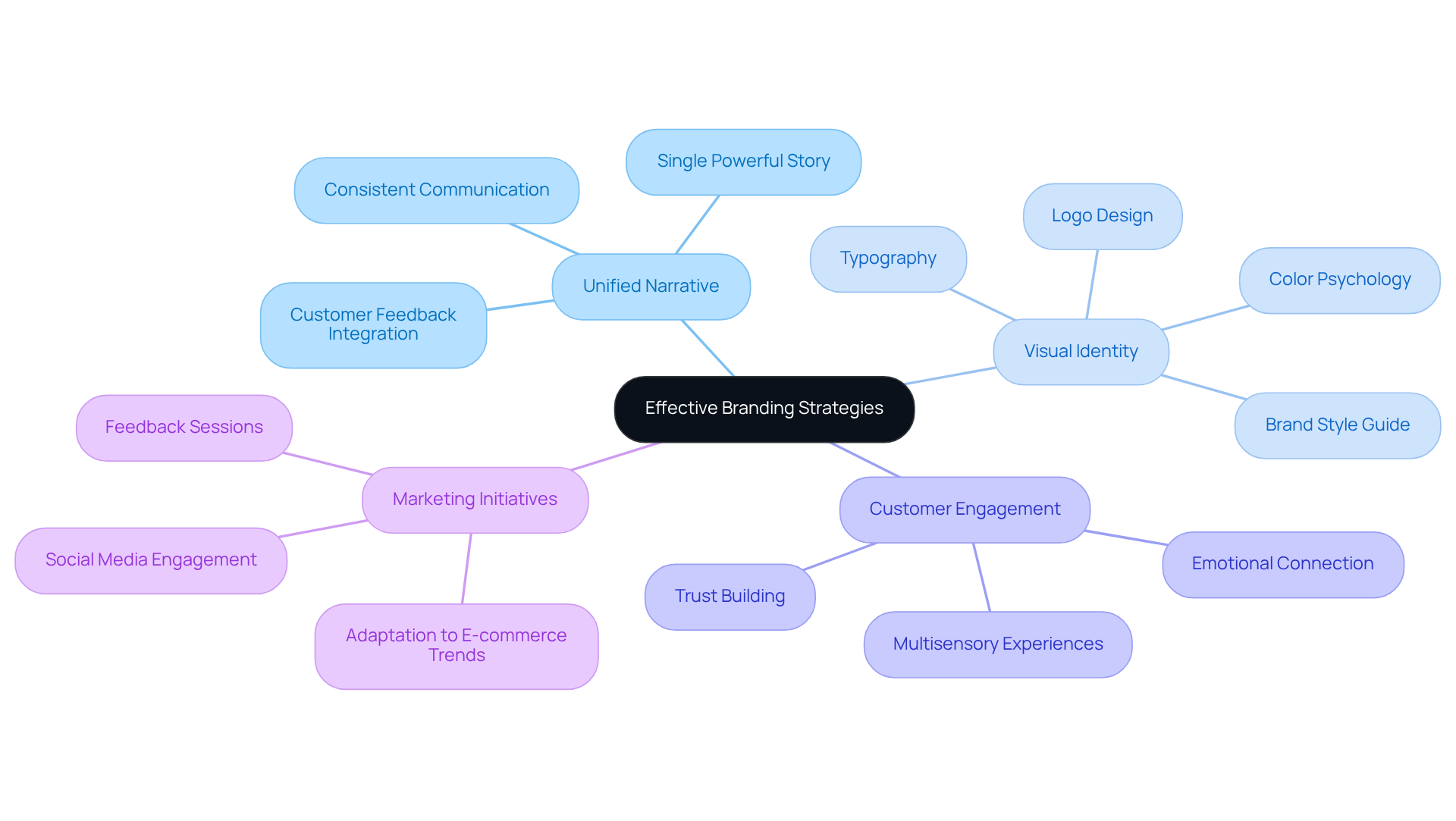
Key Takeaways: Integrating Branding and Logos for Marketing Success
Combining brand and logo identity with symbols is essential for creating a strong market presence. A carefully crafted emblem must embody the identity and values of the organization, while marketing encompasses the emotional and experiential aspects of the customer journey. At Overskies, we assert that design transcends mere aesthetics; it communicates your business's unique story through compelling visuals and strategic design. Collectively, marketing and symbols weave a unified narrative that enhances recognition and cultivates loyalty among buyers.
Consistency in branding efforts is paramount; both the brand and logo must align with core values and resonate with the target audience. This alignment empowers businesses to distinguish themselves in a competitive landscape and foster lasting relationships with clients. By merging analytics with creativity, we ensure that our designs resonate with customers earlier in the lead cycle.
Statistics reveal that:
- 84% of people are more likely to purchase from companies they feel connected to.
- 75% of consumers are inclined to buy from organizations that provide personalized content.
This underscores the necessity of a . Successful examples abound, such as Hearth & Haven, which emphasize sustainability and authenticity in their storytelling, crafting a compelling brand and logo that resonates deeply with their audience. By prioritizing these elements and adhering to the 12 principles of design, businesses can adeptly navigate the complexities of today's market and achieve enduring success.
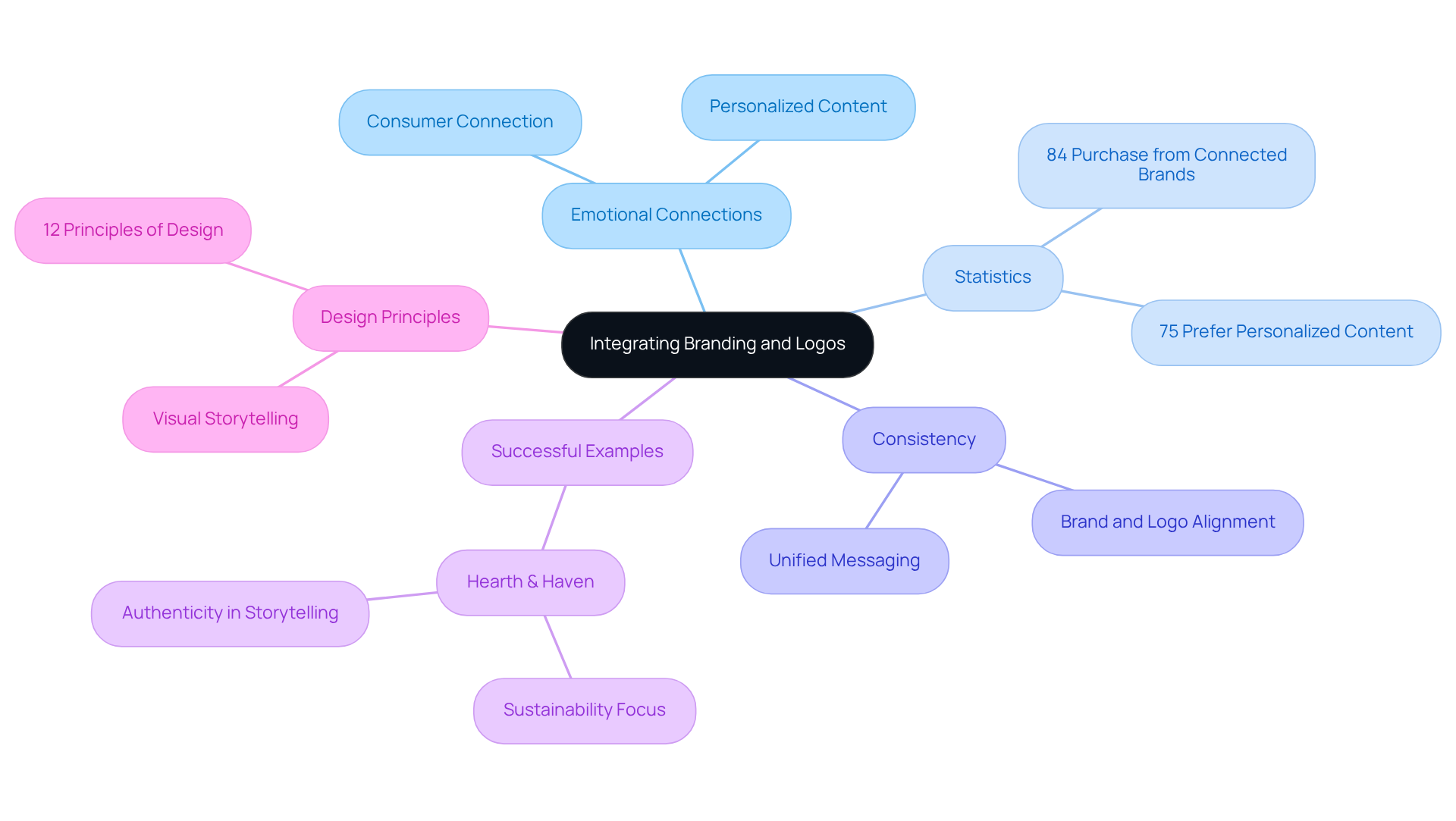
Conclusion
Understanding the distinction between branding and logos is crucial for businesses seeking to establish a formidable market presence. A logo functions as a visual representation, while branding encompasses a broader narrative that articulates a company’s core values and mission. Together, they forge an identity that resonates with consumers, fostering the trust and loyalty essential for success.
Key insights from this discussion reveal that effective branding strategies not only enhance recognition but also cultivate emotional connections with customers. Companies like Patagonia and Nike exemplify how aligning brand identity with consumer values can lead to increased loyalty and sales. Furthermore, the integration of narrative marketing and consistent messaging across platforms is vital for maintaining relevance in a competitive landscape.
In conclusion, businesses must prioritize the development of a cohesive brand narrative alongside a memorable logo to thrive in today’s market. By leveraging effective branding strategies and understanding the emotional impact of logos, companies can cultivate enduring relationships with their audience. Embracing these principles will not only differentiate a brand but also drive sustainable growth and success in an ever-evolving consumer environment.
Frequently Asked Questions
What is the process of branding?
The process of branding involves creating a unique brand and logo that establishes a distinctive identity for a business or product, encompassing its core values, mission, and overall market perception.
What is a brand mark?
A brand mark is a specific graphic element that visually encapsulates a brand's identity, serving as a recognizable symbol.
How do branding and logos relate to brand identity?
While branding and logos are essential elements of brand identity, they represent only one aspect of a comprehensive brand strategy that also includes messaging, customer experience, and visual identity.
Why is brand identity important for business success?
Brand identity is crucial for business success because companies with strong identities can command higher prices and enjoy greater customer loyalty. It helps in building trust and fostering emotional connections with consumers.
What percentage of consumers are likely to buy from trusted companies?
71% of consumers are more likely to buy from companies they trust, highlighting the importance of brand identity in consumer relationships.
How is the marketing environment changing as we approach 2025?
The marketing environment is shifting towards a greater focus on authenticity and heritage, with successful companies emphasizing their unique narratives and values rather than just aesthetics.
Can you provide an example of a brand successfully leveraging its identity?
Mary Louise Cosmetics achieved a 126% increase in repurchase rates year-over-year by leveraging its heritage-inspired narrative, illustrating the effectiveness of strong branding.
What ultimately propels business success beyond branding and logos?
A well-designed marketing strategy that includes a strong brand identity, effective messaging, and customer experience ultimately propels business success, distinguishing a business from its rivals and nurturing client relationships.
.png?width=250&height=153&name=CSI-OverskiesRebrand_LOGO-01(smaller).png)

.png?width=100&height=61&name=CSI-OverskiesRebrand_LOGO-01(smaller).png)


.png?width=88&name=CSI-OverskiesRebrand_LOGO-01(smaller).png)

